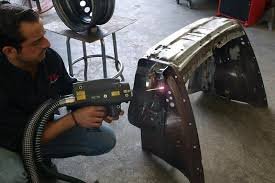Advanced composite materials, such as carbon fiber reinforced polymers (CFRP), are fundamental to modern aerospace, automotive, and renewable energy industries due to their high strength-to-weight ratio. However, these materials present significant challenges when it comes to surface preparation, paint removal, and general cleaning. Traditional methods like abrasive blasting can damage delicate fibers, while chemical solvents risk degrading the sensitive polymer matrix. Laser cleaning has emerged as a superior, high-precision solution for these delicate tasks.
The Unique Challenges of Composite Surfaces
Unlike robust metallic surfaces, composite materials are highly susceptible to damage from aggressive cleaning techniques. Mechanical abrasion can cause fiber pull-out and delamination, compromising the structural integrity of the component. Chemical stripping can be slow and may leave behind residues that interfere with subsequent bonding processes, not to mention the environmental and safety concerns associated with their use. The heat sensitivity of the polymer matrix also means that any thermal process must be exceptionally well-controlled to prevent damage. This is why a non-contact, precisely controlled method is not just beneficial, but often necessary.
The Advantage of Precision Laser Ablation
Laser cleaning operates on the principle of laser ablation, where a focused beam of light is used to vaporize contaminants from a surface. For composites, the key is the extreme level of control offered by modern laser systems. Parameters like pulse energy, duration, and frequency can be fine-tuned so that the energy is absorbed only by the coating or contaminant layer (e.g., paint, release agent), which is then ablated away. This process transfers minimal heat to the underlying composite substrate, leaving it clean and undamaged. The benefits become obvious after a direct comparison to traditional cleaning methods, which lack this level of precision and selectivity.
Key Applications for Composites
The precision of laser technology enables several critical applications in the lifecycle of composite components. From manufacturing to long-term maintenance, it provides a reliable method for surface treatment.
1. Paint Removal for Inspection and Repair: In the aerospace industry, laser cleaning is used to meticulously strip paint from composite fuselage sections and wings to allow for non-destructive inspection (NDI). This process is crucial for identifying subsurface damage or fatigue without harming the composite structure itself. The principles are similar to the process for cleaning non-metallic surfaces like wood, where energy input must be carefully managed to protect the base material.
2. Surface Preparation for Adhesive Bonding: Achieving a strong and durable bond between composite parts requires an immaculately clean and properly activated surface. Laser cleaning removes contaminants and release agents from the bonding area, creating an ideal surface texture that significantly enhances adhesive performance and long-term reliability.
3. Composite Tooling and Mold Maintenance: The molds used to create composite parts must be kept perfectly clean to ensure part quality and accuracy. Laser cleaning is highly effective in this area, and its role in mold maintenance and cleaning is to remove cured resins and release agents without any wear to the expensive and precisely machined mold surfaces.
In conclusion, laser cleaning provides an enabling technology for industries that rely on advanced composites. Its ability to perform precise, non-contact, and non-destructive surface treatment solves the inherent challenges of working with these sensitive yet critical materials, ensuring both quality and structural integrity are maintained.




